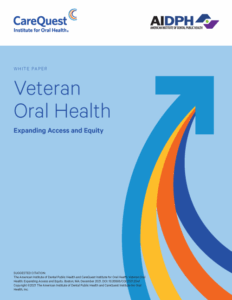Inequity in Veteran Dental Care
Roughly 19 million veterans live in the US, comprising about 6% of the total population. Those veterans are more likely to experience worse oral health outcomes — higher rates of tooth decay, higher rates of gum disease, and an increased need for restorative dental care — compared to nonveterans.
A forward-thinking white paper from CareQuest Institute and the American Institute of Dental Public Health (AIDPH) aims to shine a light on the social, structural, and individual drivers of these outcomes.
The paper is a result of convening many stakeholders across veteran organizations and oral health to review gaps in access for veterans and explore ways to address them. An evaluation of the landscape found:
- 42% of veterans reported having had gum treatment or bone loss around their teeth, which is a significantly higher proportion than reported by nonveterans (27%).
- Roughly 2 in 5 veterans described their oral health as fair or poor. This extrapolates to 8 million veterans with deficient oral health.
- Nearly 24% of veterans live in rural areas, where consistent access to care can be challenging.
The paper identifies several strategic recommendations to improve access to and quality of care, including:
- Expanding eligibility criteria for veterans to receive oral health services
- Expanding the role of Federally Qualified Health Centers and rural health clinics
- Advancing medical-dental integration in veteran health care
You may also be interested in:
- Oral Health Is Essential to Veteran Productivity and Well-Being, a report that finds nearly 600,000 veterans experienced work productivity loss in the past year due to oral health problems and examines the impact on veterans and their employers.
- Veteran Dental Care Stimulates the Economy and Improves Overall Health, a visual report that examines the economic and health implications of improving access to dental care for veterans.
- Advancing Equity Through Oral Health Fund, an overview of CareQuest Institute’s grantmaking portfolio that aligns with strategies to equitably advance systems change at the local, state, and national level.

